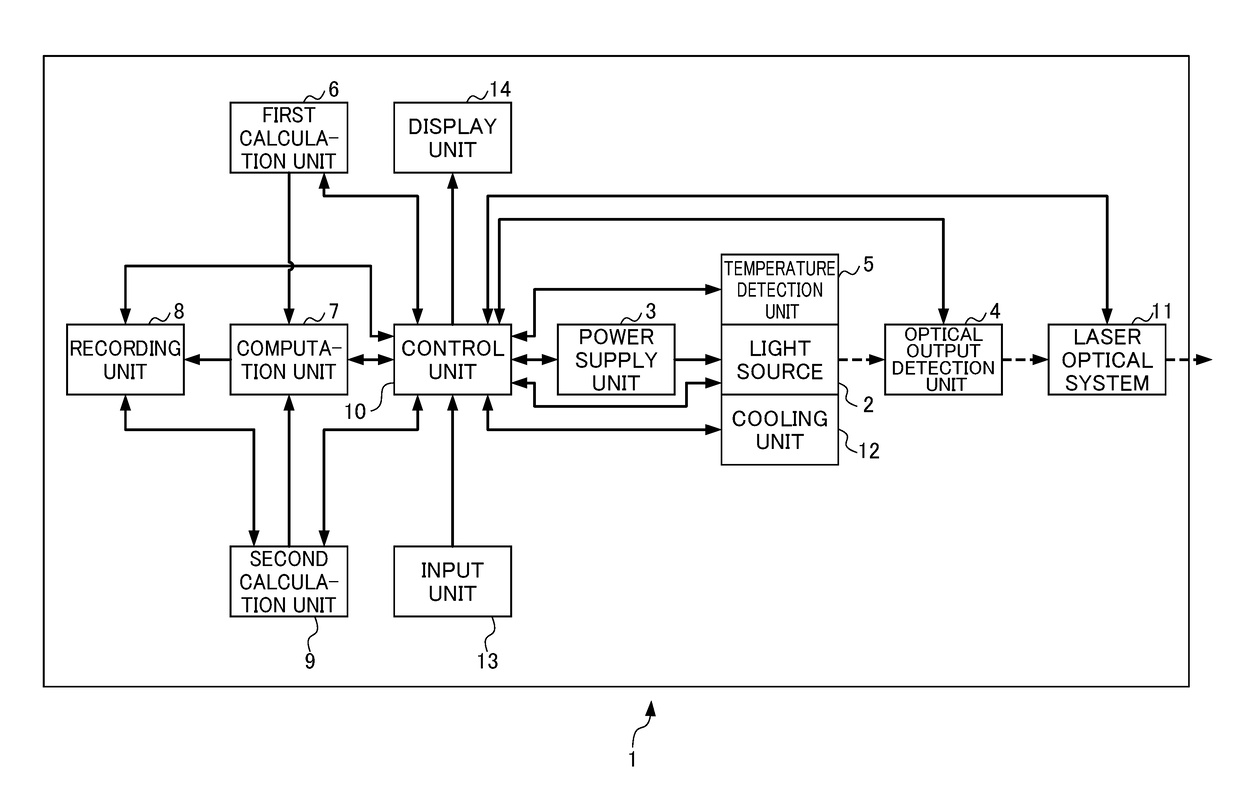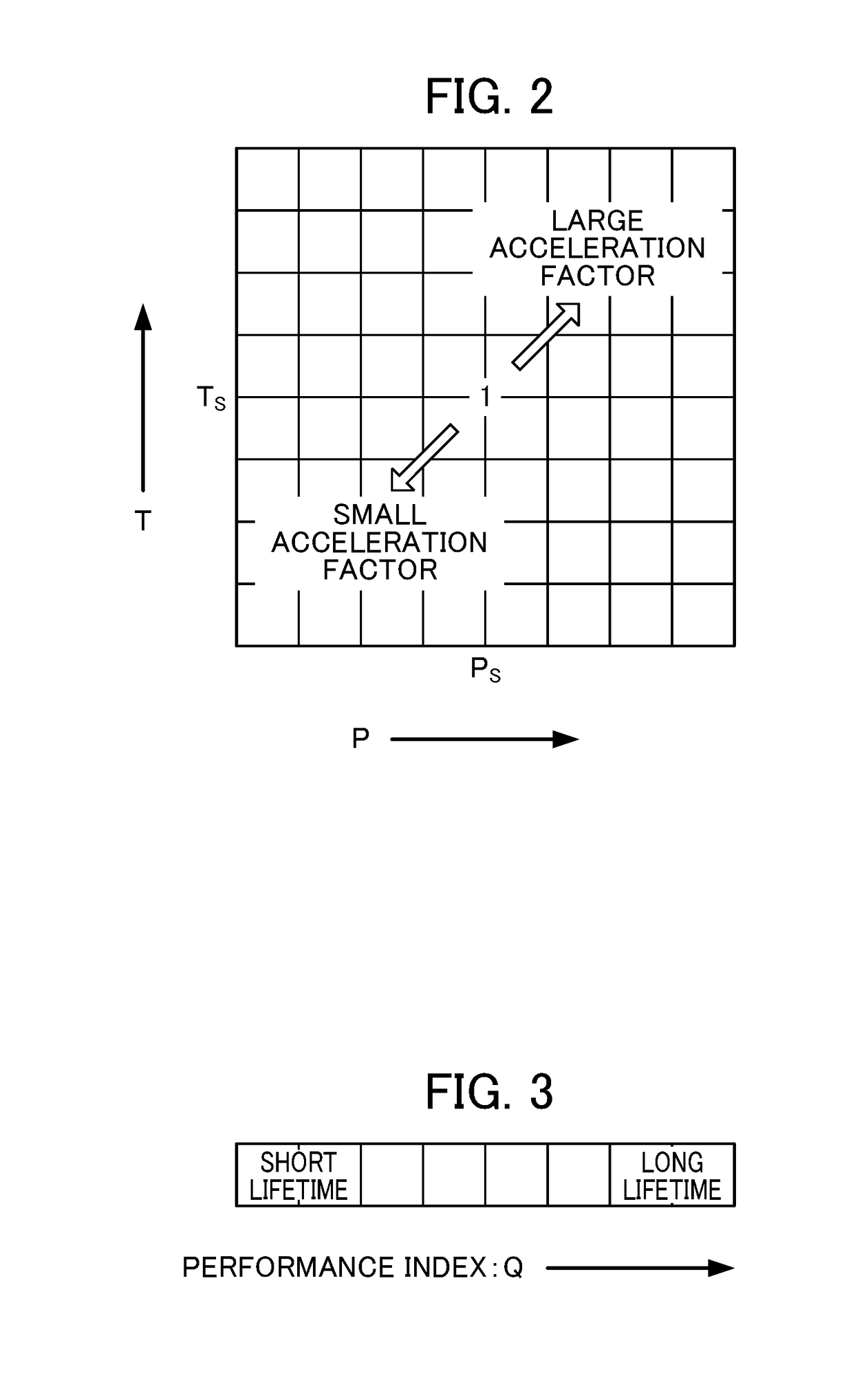Laser apparatus enabling calculation of effective driving time and remaining lifetime taking account of drive conditions including temperature
a technology of effective driving time and remaining lifetime, applied in the field of laser apparatus, can solve the problems of delay in replacement of light source, inability to feed back to the reliability control of light source, short life, etc., and achieve accurate calculation, accurate estimation of remaining lifetime, and further reduction of reference data required for calculation of acceleration factor
- Summary
- Abstract
- Description
- Claims
- Application Information
AI Technical Summary
Benefits of technology
Problems solved by technology
Method used
Image
Examples
first embodiment
[0073]FIG. 1 is a schematic view showing the structure inside a laser apparatus 1 according to a first embodiment of the present invention. As shown in FIG. 1, the laser apparatus 1 according to the first embodiment includes: at least one light source 2 that functions as a laser source or excitation light source; at least one power supply unit 3 that supplies driving current to the light source 2; at least one optical output detection unit 4 that detects the optical output from the light source 2; at least one temperature detection unit 5 that detects the temperature of the light source 2 or a member thermally connected to the light source 2; a first calculation unit 6 that calculates an acceleration factor F (P,T) of lifetime consumption of the light source 2, which depends on the temperature T and drive condition value P, based on a case of a temperature TM detected by the temperature detection unit 5 or a temperature TL of the light source 2 obtained from a temperature TM detecte...
second embodiment
[0085]In a laser apparatus according to a second embodiment of the present invention, the dependence on the effective cumulative driving time tc is also considered in the acceleration factor F (P,T) calculated by the first calculation unit 6. FIG. 4 shows an organizational example of a data table referenced by the laser apparatus of a second example upon calculation of the acceleration factor F (P,T). A two-dimensional data table of one layer shown in FIG. 2 is included for each of a plurality of effective cumulative driving times. Upon referencing the data table of FIG. 4, in the case of there not being a data table in which effective cumulative driving time tc matches, it is possible to calculate the acceleration factor F (P,T) by interpolation, etc. When reaching the lifetime late stage, for the acceleration factor F (P,T) larger than the reference value being 1, even if the drive condition value P and temperature T are the same, there is a tendency for the acceleration factor F ...
third embodiment
[0086]In a laser apparatus according to a third embodiment of the present invention, the second calculation unit 9 can calculate the remaining lifetime τR of the light source 2 at an arbitrary time tp by subtracting the effective cumulative driving time tc until the arbitrary time tp recorded in the recording unit 8, from the whole lifetime τL of the light source 2 calculated relative to at least one characteristic of the light source 2 among the performance index Q of the light source 2 and the change rate of the performance index Q. In other words, it is possible to calculate as τR=τL−τc. The second calculation unit 9 can calculate the remaining lifetime τR by subtracting the effective cumulative driving time tc from the whole lifetime τL of the light source 2 calculated from the initial characteristic of the performance index Q, e.g., performance index Q at the setting time ts (i.e. effective cumulative driving time tc=0). Since the individual variations in light sources 2 such a...
PUM
 Login to View More
Login to View More Abstract
Description
Claims
Application Information
 Login to View More
Login to View More - R&D
- Intellectual Property
- Life Sciences
- Materials
- Tech Scout
- Unparalleled Data Quality
- Higher Quality Content
- 60% Fewer Hallucinations
Browse by: Latest US Patents, China's latest patents, Technical Efficacy Thesaurus, Application Domain, Technology Topic, Popular Technical Reports.
© 2025 PatSnap. All rights reserved.Legal|Privacy policy|Modern Slavery Act Transparency Statement|Sitemap|About US| Contact US: help@patsnap.com



